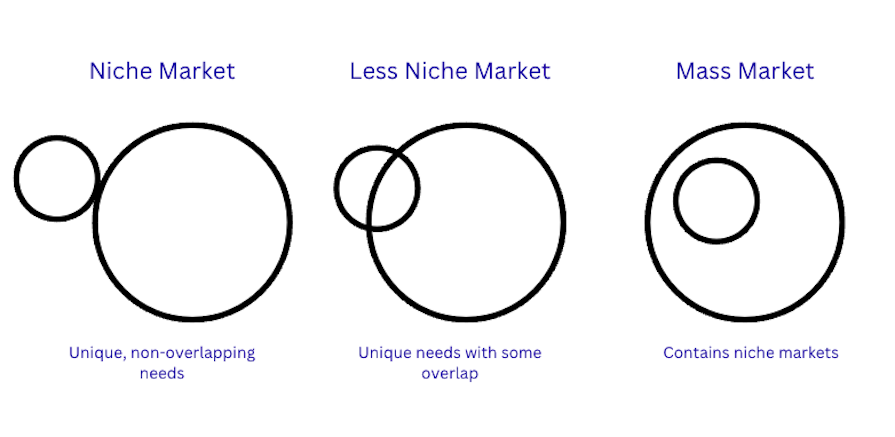When you introduce a product into a new market, it’s important that you carefully define the market you want to pursue. Ultimately, your market is the central component of any go-to-market strategy, influencing how you build, market, and sell your product.

When approaching a market, you can choose to go either broad or niche. When you “go broad,” you’re typically going after the mass market. This might be something like all workers who use spreadsheets. Niche markets, on the other hand, are more narrowly defined. For example, you could target workers who use spreadsheets and work remotely.
When you define markets, you want to specify which persona you’re going after, or what use case you’re trying to solve for. The more specific your definition, the more niche your market is.
A niche market is a clearly defined set of potential customers who share similar traits and needs that are, in aggregate, specific and unique to that set of customers. Niche markets are usually more narrow, and thus smaller, than the mass market. This allows for a more efficient, targeted go-to-market strategy.
Niche markets are defined similarly to the way that mass markets are, but are more specific in scope. Because niche markets are more narrow, they’ll often have more characteristics to distinguish themselves. Typically, you’ll want to define a niche market using a collection of the following:
A large niche market might look a bit more like a mass market, so it’s definitely a sliding scale. But typically, truly niche markets are smaller and more connected. They will share similar needs, want similar solutions, and are more likely to talk to each other as part of a smaller community.
A good way to think about niche markets versus mass markets is through a venn diagram. Extremely niche markets have little overlap in needs compared to other markets. Less niche markets may have overlapping needs, with a handful of unique needs. Finally, a mass market will have strong overlap with other niche markets, and contains many niche markets:

It’s a difficult decision whether to pursue a niche or mass market. Mass markets can be appealing as they are large and full of potential. However, they can also be difficult to tackle because they are so large. Any effort to approach the market could be easily diluted.
If you have enough resources to tackle the mass market, or you have a good plan on how you will break through the noise, mass markets are amazing places to be. If not, there are some real benefits to identifying a niche market.
Although it might sound like having specific needs is a bad thing, this can actually be a very good thing. It’s important to differentiate as a company, either via your product or go-to-market motion. Because niche markets have specific needs, you can design a product that uniquely meets their needs and describe that unique differentiation in your go-to-market strategy.
Let’s think of an example niche market — remote workers who work in tech companies.
Unlike workers who go into work every day, remote workers need tools to help them collaborate with other team members. Teams who work in the office can do brainstorming sessions on whiteboards and sticky notes, whereas remote workers can’t. By building a collaboration tool specifically built for remote workers, it’s possible to completely capture that market with a different set of features than what the mass market needs.
Although it’s true that you can generate network effects in mass markets, niche markets are a natural fit for network effects because members of niche markets have common shared needs. They likely know other people within their same niche market who have similar problems. If you successfully solve problems for one customer, you’ll be able to successfully solve problems for others.
For example, primary care private practices have a lot of doctors who are worried about how to run their business and compete with larger hospitals. They likely network with other private practices, go to conferences, or engage in similar social networks. By tapping into these niche markets and finding where their members spend their time, you can super power your go-to-market, capturing more users with less effort.
Although mass markets are larger than niche markets, they are also harder to dominate as the number one player. Mass markets can contain many niche markets, so when you compete within a mass market, you are competing not only with other mass market competitors, but also niche market competitors.
When there are so many options for customers to choose from, it’s easy for your messaging to get lost in the noise. Mass markets pose a challenge for positioning your product in a compelling way. That’s perhaps what makes Apple’s messaging so magical — it’s able to find a way to differentiate and resonate even within a mass market.
On the other hand, niche markets are easier to dominate not just because they’re smaller, but because they are easier to target and message. You can specifically target users’ unique needs, crafting a message that resonates with what they’re looking for.
You can also find niche markets by monitoring sites where your prospective users communicate. For example, developers tend to spend a lot of time on HackerNews and Reddit, so if you go after those channels by generating content that resonates there, you’ll quickly reach your developer audience.
Although it might sound like going after a niche market means that you have to sacrifice mass markets, this isn’t necessarily true. Niche markets are effective starting points for companies looking to expand into other markets. In fact, many successful companies start out in a specific niche before expanding to more use cases.
For example, when Apple Watches came out, they targeted early adopters who cared about fitness tracking. But now, Apple Watches are widely used by people who aren’t early adopters of new technologies.
When it comes to developing a product for a niche market, the strategy differs from what you might be familiar with when pursuing mass markets. Let’s cover some of the basics.
As mentioned earlier, niche markets often have strong network effects and spend time in similar social networks. So if you’re looking to tackle a niche market, you can start with figuring out where your customers spend their time.
User interviews can be very helpful here. You can call up a handful of early users and ask them where they heard about you, and where they typically hear about other products. This is a good way to understand where users spend their time.
Here are some examples of channels that you should seek to identify:
You should try to actively leverage the strong network effects of niche markets by encouraging referrals. Although everyone hopes that their product is good enough to drive word of mouth, the truth is that giving your customers a little push only helps drive up referrals.
Some examples of how you might drive referrals include:
Building a community is difficult, but well worth the time if you can get it to work. Communities are hard because they take a lot of effort. You need to find people to populate the community and ensure that they remain engaged. No one likes communities with zero engagement.
However, if your niche market doesn’t have a strong community platform yet, this is an amazing opportunity to take advantage of. If you can become the place where everyone in your niche community networks and gets together, you can capture a captive audience. Although not everyone who joins your community will buy your product immediately, they will constantly interact with your brand and business as they engage with your community.
Finally, you can use targeted ads to spread your brand and message to niche markets. Today’s social networks and search platforms all have granular ways to target your niche audience. This is a traditional strategy, but also an effective one as long as you keep an eye on cost.
Perhaps a more modern strategy would be to engage with influencers who your niche markets follow. These influencers can promote your product to their followers, helping you target your niche market.
The key to developing a product for a niche market is to spend a lot of time understanding customer use cases. You should make sure you have a cohort of users that you can tap into to get feedback on what to build. This could be your niche community that you built from the ground up, design partners who are interested in your product, beta users, or even potential users you find through other channels.
The most important thing to figure out when developing a product for niche markets is identifying a unique, unsolved problem. For example, surgeons have to stand for a really long time, but they also want shoes that match their scrubs. So if you were to design work appropriate, comfortable shoes that look good with scrubs, you’d be meeting their unique needs.
Beyond meeting unique needs, you also want to make sure those needs are important enough for people to choose your product over others. For example, although it’s nice for shoes to look good with scrubs, it’s probably not important enough for surgeons to choose your shoes over the newest Nikes.
Now that you’ve decided what niche market to go after, figured out how to market your product, and built a product for that niche market, how do you know if things are working out?
Ultimately, the way to analyze the success of tackling a niche market is really the same as mass markets. How fast is your revenue growing? How much does it cost to acquire a customer? How many customers retain after a year, do they come back and re-purchase, and what’s the lifetime value of these customers?
These high-level business metrics are the same whether you pursue a mass market or a niche one.
Ultimately, going after a niche market is a very good strategy for any company starting out with a new product or product line. Niche markets are easier to dominate, easier to target, and easier to build a differentiated product for. However, niche markets also carry risks.
A niche market might not be unique or severe enough to merit a niche product, or the market might be too small to sustain your business. As you evaluate your success going after a niche market, keep those top level business metrics in mind. If you find that you’re not able to achieve success, it might be time to either move to a different niche market, or expand into a larger one.
Featured image source: IconScout

LogRocket identifies friction points in the user experience so you can make informed decisions about product and design changes that must happen to hit your goals.
With LogRocket, you can understand the scope of the issues affecting your product and prioritize the changes that need to be made. LogRocket simplifies workflows by allowing Engineering, Product, UX, and Design teams to work from the same data as you, eliminating any confusion about what needs to be done.
Get your teams on the same page — try LogRocket today.

Promotions depend on proof. This guide shows PMs how to capture wins, feedback, and impact before review season.

Most teams fail at autonomy. Learn how clear rules help product teams move faster without micromanagement.

A practical framework for PMs to use AI in ideation without sacrificing judgment, strategy, or decision quality.

A practical five minute revenue estimation method to help product managers compare ideas, drop low impact features, and prioritize smarter.